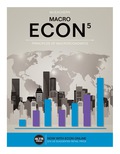
Sub-part
A
The ways in which a $10,000 deposit into a checking account would initially affect a bank’s assets and liabilities:
Concept Introduction:
The Federal Reserve and banking system are responsible for the creation of money in the economy. The first step of this money creation process starts when the Federal Reserve injects money in the economy by buying bonds. This money is stored in a bank. Then, the bank would keep the
Sub-part
B
The ways in which a bank makes a loan of $1000 by establishing a checking account for $1000 would initially affect a bank’s assets and liabilities:
Concept Introduction:
The Federal Reserve and banking system are responsible for the creation of money in the economy. The first step of this money creation process starts when the Federal Reserve injects money in the economy by buying bonds. This money is stored in a bank. Then, the bank would keep the required reserves with themselves, and lent the remaining excess reserves. These excess reserves will then be stored with some other bank and the other bank would also keep the required reserve and make a loan for the remaining amount. These excess reserves keep flowing in the economy, thus, creating money at every stage.
Sub-part
C
The ways in which a loan of $1000 established by checking account for $1000 is spent would initially affect a bank’s assets and liabilities:
Concept Introduction:
The Federal Reserve and banking system are responsible for the creation of money in the economy. The first step of this money creation process starts when the Federal Reserve injects money in the economy by buying bonds. This money is stored in a bank. Then, the bank would keep the required reserves with themselves, and lent the remaining excess reserves. These excess reserves will then be stored with some other bank and the other bank would also keep the required reserve and make a loan for the remaining amount. These excess reserves keep flowing in the economy, thus, creating money at every stage.
Sub-part
D
The ways in which a bank should write off a loan would initially affect a bank’s assets and liabilities:
Concept Introduction:
The Federal Reserve and banking system are responsible for the creation of money in the economy. The first step of this money creation process starts when the Federal Reserve injects money in the economy by buying bonds. This money is stored in a bank. Then, the bank would keep the required reserves with themselves, and lent the remaining excess reserves. These excess reserves will then be stored with some other bank and the other bank would also keep the required reserve and make a loan for the remaining amount. These excess reserves keep flowing in the economy, thus, creating money at every stage.
Trending nowThis is a popular solution!

- Explain how banks create money using your own example of a T-account.Define the deposit and RRR clearly.arrow_forwardYou are getting married and are unhappy with your present bank. Discuss how you should go about choosing a new bank and opening an account. Consider the factors that are important to you in selecting a bank – such as the type and ownership of accounts (individual or joint) and bank fees and charges, among others.arrow_forwardWill the amount of new loan be affected if the additional $400,000 was deposited in the Second National Bank?arrow_forward
- Explain the impact of interest rate change in a bank income and net wortharrow_forwardWould you consider deposits of money in banks and similar situations, such as savings deposit and current account deposits, contracts of depositum or mutuum?arrow_forwardExplain the role of capital in protecting a bank from insolvency.arrow_forward
- Coin Bank has deposits of $350 million. It holds reserves of $30 million and government bonds worth $70 million. If the bank sells its loans at market value of $400 million, what will its total assets equal? $500 million $750 million $450 million $380 millionarrow_forwardb). Explain the economic significance of rural banks to the economy? c). Enumerate the specific functions of the Bank of Ghana as enshrined in the Bank of Ghana Act 612 of 2002arrow_forwardWill the additional $400,000 which was deposited in the Second National Bank affect the new loan?arrow_forward


 Exploring EconomicsEconomicsISBN:9781544336329Author:Robert L. SextonPublisher:SAGE Publications, Inc
Exploring EconomicsEconomicsISBN:9781544336329Author:Robert L. SextonPublisher:SAGE Publications, Inc Principles of Economics 2eEconomicsISBN:9781947172364Author:Steven A. Greenlaw; David ShapiroPublisher:OpenStax
Principles of Economics 2eEconomicsISBN:9781947172364Author:Steven A. Greenlaw; David ShapiroPublisher:OpenStax






